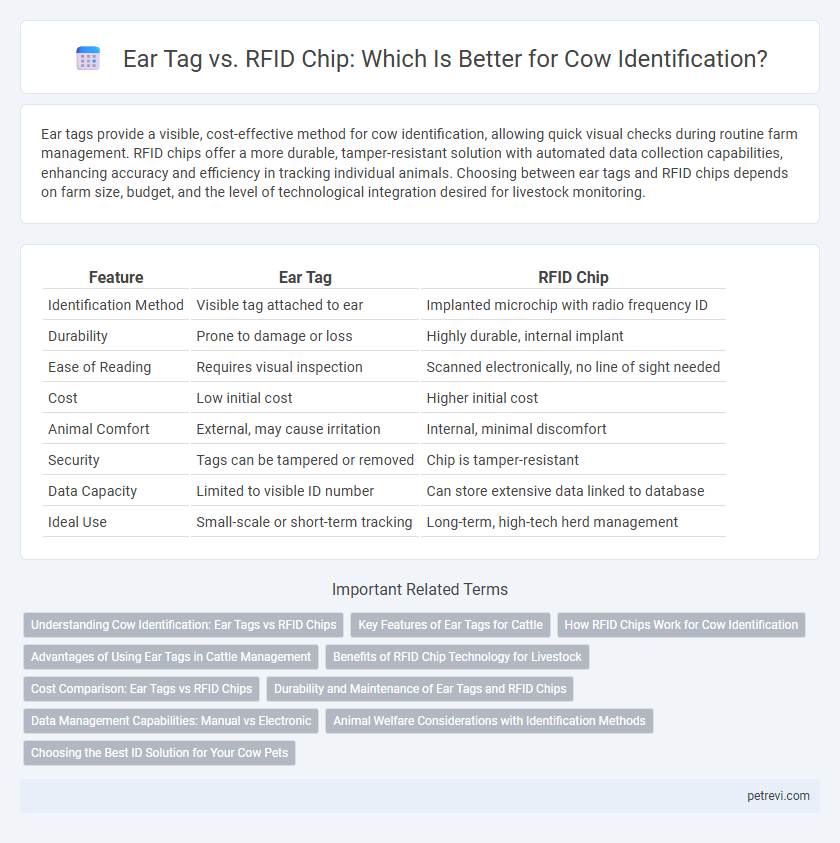Ear tags provide a visible, cost-effective method for cow identification, allowing quick visual checks during routine farm management. RFID chips offer a more durable, tamper-resistant solution with automated data collection capabilities, enhancing accuracy and efficiency in tracking individual animals. Choosing between ear tags and RFID chips depends on farm size, budget, and the level of technological integration desired for livestock monitoring.
Table of Comparison
| Feature | Ear Tag | RFID Chip |
|---|---|---|
| Identification Method | Visible tag attached to ear | Implanted microchip with radio frequency ID |
| Durability | Prone to damage or loss | Highly durable, internal implant |
| Ease of Reading | Requires visual inspection | Scanned electronically, no line of sight needed |
| Cost | Low initial cost | Higher initial cost |
| Animal Comfort | External, may cause irritation | Internal, minimal discomfort |
| Security | Tags can be tampered or removed | Chip is tamper-resistant |
| Data Capacity | Limited to visible ID number | Can store extensive data linked to database |
| Ideal Use | Small-scale or short-term tracking | Long-term, high-tech herd management |
Understanding Cow Identification: Ear Tags vs RFID Chips
Cow identification methods primarily include ear tags and RFID chips, each offering distinct advantages for herd management and traceability. Ear tags are visible, cost-effective, and easy to apply but can be lost or damaged, whereas RFID chips provide reliable, tamper-proof identification through electronic scanning, enhancing data accuracy and animal tracking. Choosing between ear tags and RFID chips depends on farm size, budget, and the need for real-time monitoring or regulatory compliance in livestock management.
Key Features of Ear Tags for Cattle
Ear tags for cattle provide a visible and cost-effective identification method, featuring easy application and compatibility with manual and electronic scanning systems. They offer durability with weather-resistant materials and customizable numbering or color codes for quick herd management. Unlike RFID chips that require specialized readers, ear tags enable straightforward visual identification, making them ideal for routine monitoring on farms.
How RFID Chips Work for Cow Identification
RFID chips for cow identification use radio frequency signals to communicate with a reader device, allowing for quick and accurate data capture without visual contact. Each RFID chip contains a unique electronic code that stores individual cow information such as health records, breeding history, and movement tracking. This technology enhances herd management efficiency by enabling real-time monitoring and reducing errors compared to traditional ear tags.
Advantages of Using Ear Tags in Cattle Management
Ear tags offer a cost-effective and easy-to-install solution for cattle identification, allowing farmers to quickly visually verify individual cows during routine handling. These tags are highly durable, resistant to environmental conditions, and can display clear, large numbers visible from a distance, facilitating efficient herd management. Unlike RFID chips, ear tags require no specialized scanning equipment, enabling immediate and straightforward identification in various farm settings.
Benefits of RFID Chip Technology for Livestock
RFID chip technology enhances livestock management by enabling quick, accurate, and non-intrusive identification of cows, reducing human error associated with manual ear tag reading. The durability and tamper-resistance of RFID chips provide long-term, reliable tracking essential for disease control, breeding programs, and inventory management. Integration with farm management software allows seamless data collection and analysis, improving herd health monitoring and operational efficiency.
Cost Comparison: Ear Tags vs RFID Chips
Ear tags for cow identification typically cost between $0.50 and $2 per tag, making them a cost-effective choice for large herds, while RFID chips range from $2 to $5 each, reflecting higher initial investment. Installation costs for ear tags are generally lower due to simple application methods, whereas RFID chip implantation may require specialized equipment or veterinary assistance, increasing overall expenses. Despite higher upfront costs, RFID chips offer enhanced durability and long-term savings on re-tagging and data management compared to ear tags.
Durability and Maintenance of Ear Tags and RFID Chips
Ear tags for cows offer a cost-effective and easily replaceable identification method but are prone to damage from environmental factors and animal interactions, requiring regular inspection and replacement. RFID chips provide superior durability as they are implanted under the skin, minimizing wear and physical damage, which significantly reduces maintenance needs over the cow's lifetime. However, RFID systems require specialized scanning equipment and periodic functionality checks to ensure consistent read accuracy and data integrity.
Data Management Capabilities: Manual vs Electronic
Ear tags offer a straightforward, manual method for cow identification but rely heavily on visual inspection and manual data recording, increasing the risk of human error and data loss. RFID chips enable electronic identification, providing automated data capture, real-time tracking, and seamless integration with herd management software, improving accuracy and efficiency. Electronic systems enhance data management capabilities by allowing instant access to animal health records, vaccination history, and breeding information, optimizing decision-making processes on the farm.
Animal Welfare Considerations with Identification Methods
Ear tags and RFID chips serve as primary identification methods for cows, with animal welfare considerations impacting their selection. Ear tags can cause discomfort, skin irritation, or infections if improperly applied or maintained, while RFID chips, implanted under the skin, minimize external injury risk but involve a minor procedure requiring veterinary expertise. Effective cow identification balances ease of monitoring herd health and behavior with minimizing stress and physical harm to the animal.
Choosing the Best ID Solution for Your Cow Pets
Ear tags provide a cost-effective and easily visible method for cow identification, allowing for quick herd management and health tracking. RFID chips offer advanced data storage and real-time monitoring capabilities, enhancing traceability and reducing human error through electronic scanning. Selecting the best ID solution depends on balancing budget constraints, the need for precision, and the scale of your cattle operation.
Ear Tag vs RFID Chip for Cow Identification Infographic

 petrevi.com
petrevi.com